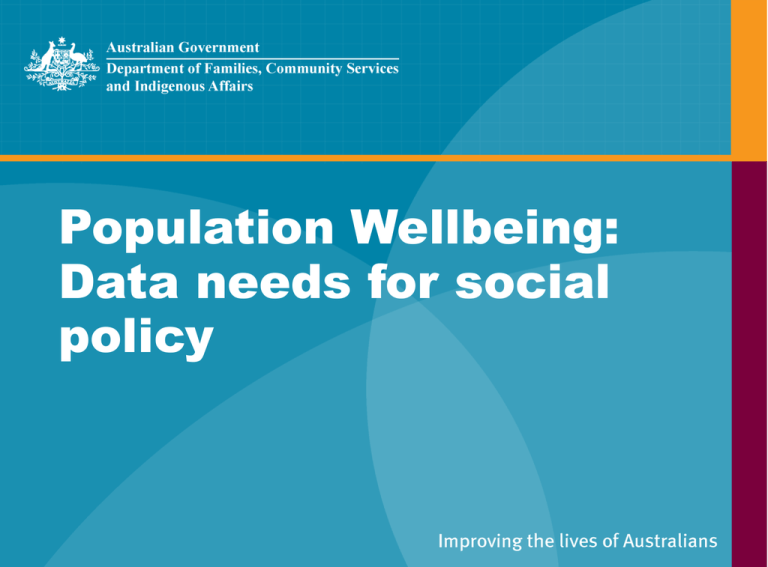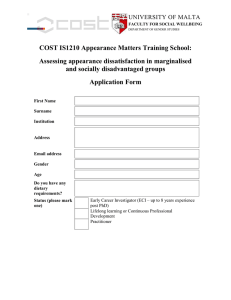FaCSIA Presentation, 8-6-06 final.ppt
advertisement

Population Wellbeing: Data needs for social policy Outline of presentation • Outline the purpose and policy context of FaCSIA • Highlight some trends in policy thinking and their implications for how we collect and use data • Illustrate these principles in relation to some current policy interests of FaCSIA • BUT…not seeking to attempt to articulate a coherent framework: • The draft family framework is offered here as a point of discussion Research and Analysis Branch Population Wellbeing: Data Needs for Social Policy FaCSIA’s purpose • Improving the lives of Australians by helping to build the capacity and wellbeing of individuals, families and communities Research and Analysis Branch Population Wellbeing: Data Needs for Social Policy FaCSIA’s strategic themes - 1 • Maximising economic and social participation including through business, community and other partnerships • Focussing on early intervention, especially for children and families • Assisting those who are most disadvantaged • Achieving better outcomes for Indigenous Australians Research and Analysis Branch Population Wellbeing: Data Needs for Social Policy FaCSIA’s strategic themes - 2 • Responding to intergenerational change • Balancing rights and responsibilities in the design and delivery of government assistance • Providing and supporting Whole of Government leadership Research and Analysis Branch Population Wellbeing: Data Needs for Social Policy Policy perspectives - 1 • A focus on disadvantage • A dynamic view of policy issues - pathways and transitions • An interest in influencing behaviour – promoting personal responsibility and self-reliance Research and Analysis Branch Population Wellbeing: Data Needs for Social Policy Policy perspectives - 2 • An appreciation of interactions between different spheres of policy – social and economic; health and welfare; employment and wellbeing; work and family • A recognition of the changing environment – ageing population, different family dynamics, flexible labour market Research and Analysis Branch Population Wellbeing: Data Needs for Social Policy Some questions about data gaps • What data is missing, that could help us answer policy questions? • Is the data we have in the right form to answer policy questions? • • • • Collecting items together from different domains Linking data from different sources Understanding dynamics (ie, the time dimension) System views, and drilling down to capture diversity and observe effects Research and Analysis Branch Population Wellbeing: Data Needs for Social Policy FaCSIA’s response to data gaps • Administrative Data Sets • Based on Centrelink payment data • Longitudinal with fortnightly panels • Linkages – internal, related data, survey data • New policy insights • Lone parents with multiple spells on income support • Long term welfare dependence of teenage mothers • Outcomes for children of income support mothers Research and Analysis Branch Population Wellbeing: Data Needs for Social Policy Longitudinal surveys • • HILDA – Household, Income and Labour Dynamics in Australia LSAC – Longitudinal Study of Australian Children • Longitudinal surveys can also be used understanding dynamics – i.e., the time dimension. • Multi domain – allowing researchers to explore interactions between different spheres of policy interest Research and Analysis Branch Population Wellbeing: Data Needs for Social Policy Longitudinal data • Specifically, data from longitudinal surveys can be used to: i. Make distinctions between transitory and persistent characteristics (e.g., poverty or wealth); ii. Study flows between states (e.g., employed/unemployed); iii. Conduct studies of intergenerational consequences such as poverty and dependence; iv. Estimate change surrounding certain events (e.g., health status before and after marital separation); and v. Estimate more sophisticated behavioural models. Research and Analysis Branch Population Wellbeing: Data Needs for Social Policy Longitudinal data and policy analysis • Longitudinal data can contribute to our understanding of dynamic policy issues. • For instance, the HILDA survey indicates that in 2001, 13.2% of individuals were classified as being ‘in poverty’. • However, the HILDA survey can be used to examine the persistence of poverty between 2001 and 2003. For example, 3.4% of individuals were classified as being poor in all three years. • Moreover, nearly one-fifth (~20%) of individuals were poor in at least one year. Research and Analysis Branch Population Wellbeing: Data Needs for Social Policy Examples of data gaps • Missing data • Indigenous identified data • Sample views • Families • Data views • Child Care data with outcomes Research and Analysis Branch Population Wellbeing: Data Needs for Social Policy Indigenous identified data • Australia’s biggest social policy challenge • Data to support policy is not strong • Heavy reliance on Indigenous identifiers in data collected for other purposes • Need to: • Improve Indigenous identification in survey and administrative data • Collect Indigenous specific data Research and Analysis Branch Population Wellbeing: Data Needs for Social Policy Views of families • Currently, data is collected on families residing in a single household • What is missing: • Non-intact (or separated) families • Dependent children not at home • Dependent elders not at home • Adults ‘living apart together’ Research and Analysis Branch Population Wellbeing: Data Needs for Social Policy Linking child care to outcomes • Currently, industry data and usage data • But can’t measure key outcomes • Impact on labour force participation • Impact on child development Research and Analysis Branch Population Wellbeing: Data Needs for Social Policy Conclusion • FaCSIA is making a substantial effort to address current data gaps • Current longitudinal surveys and administrative data provide a rich source of information that can be used in policy development • There is, however, a case for collecting additional data to respond to our emerging policy challenges, such as: • • • Indigenous identified data; Non-intact (or separated families); and Linking child care data to outcomes. Research and Analysis Branch Population Wellbeing: Data Needs for Social Policy






